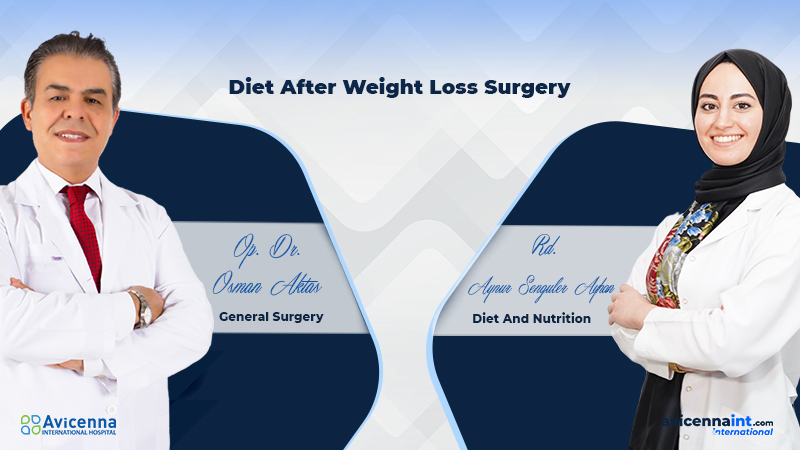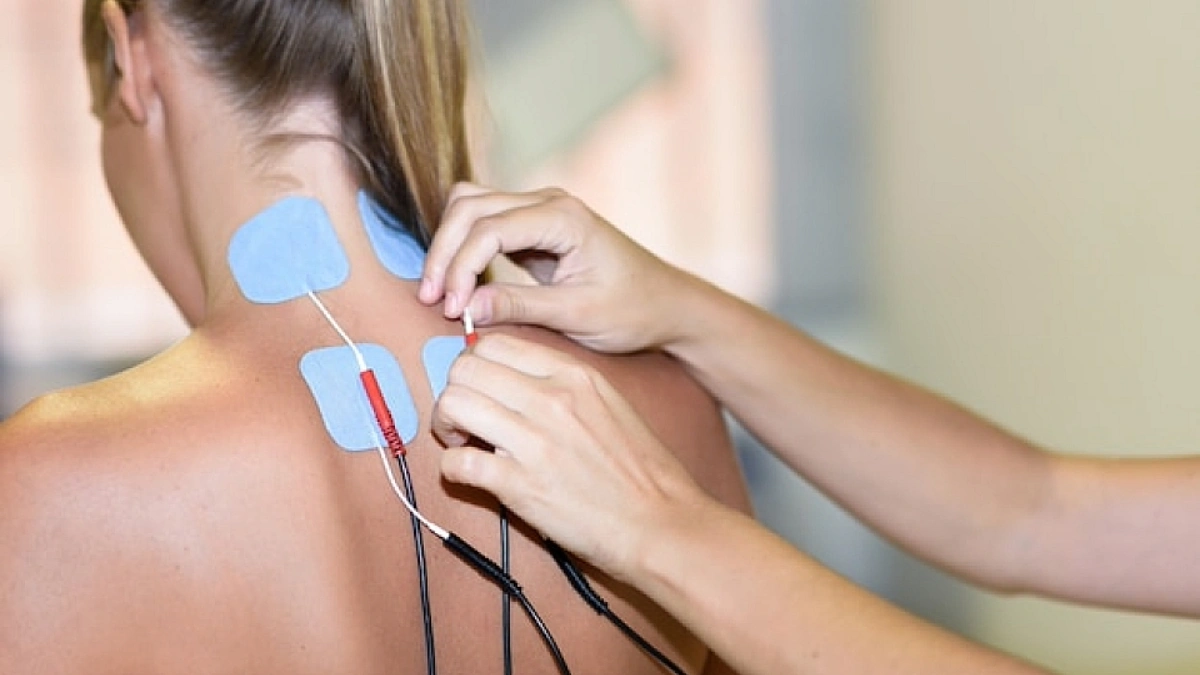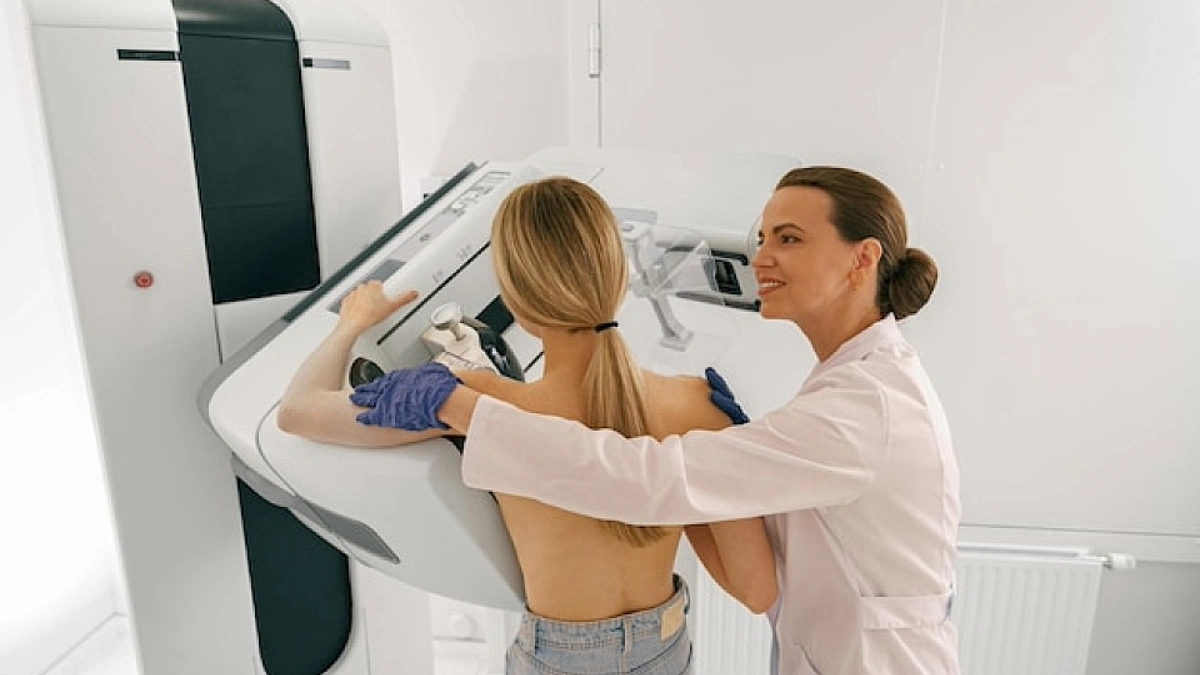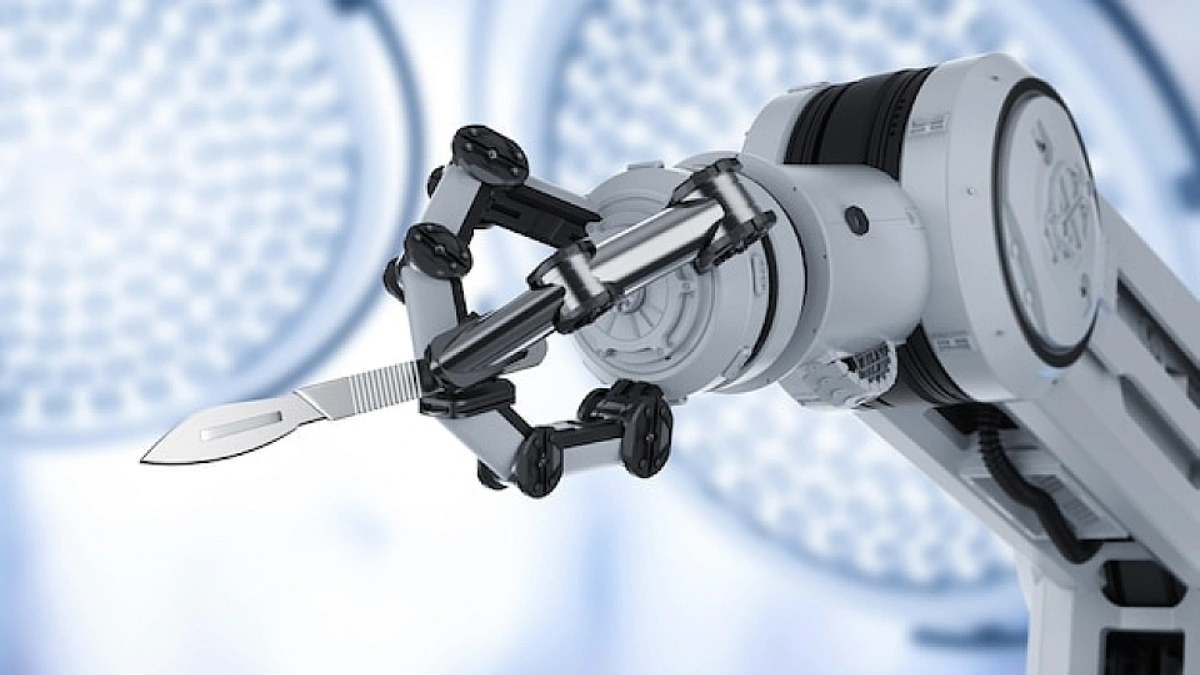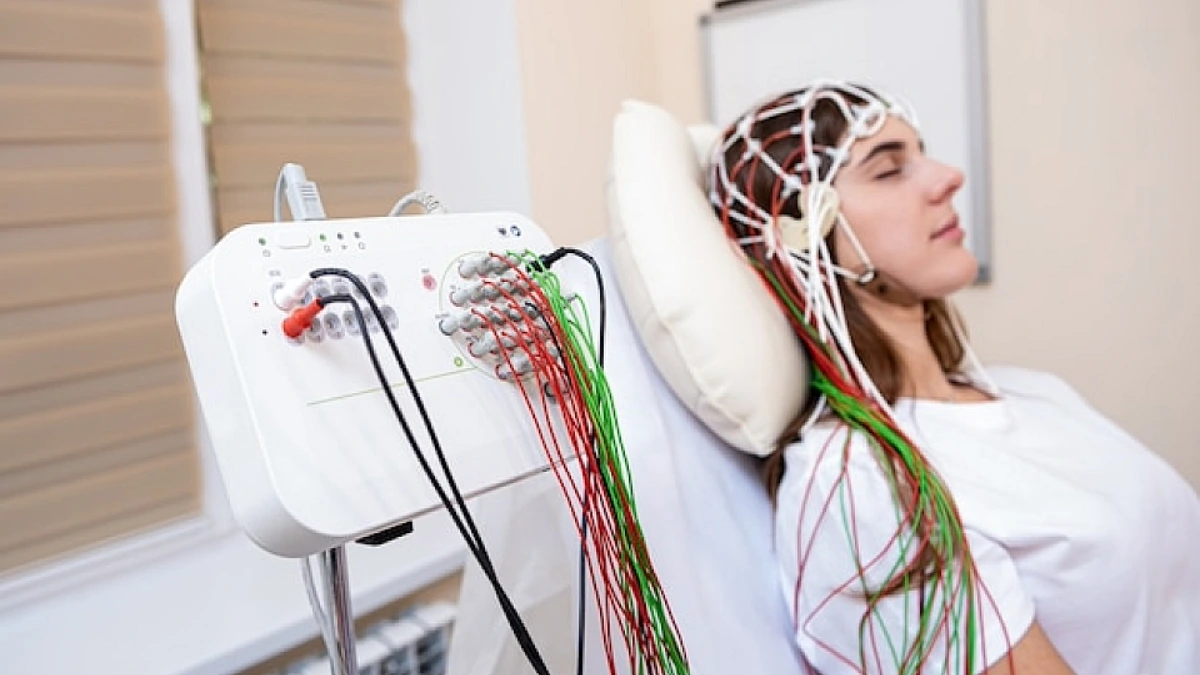Nutrition Guidelines After Metabolic Surgery
Goals Of Nutritional Therapy
Proper nutrition therapy is very important in the post-surgical period.
There are two main goals of nutritional therapy during this period:
- Providing adequate energy and nutrient intake is important for promoting tissue healing and preserving lean body mass during excessive weight loss.
- Postoperative nutrition management involves planning meals and beverages to prevent the development of reflux, early satiety, and dumping syndrome while also preventing weight regain after surgical operations.
The first thing you need to change along with your decision to undergo surgery is your eating habits.
You should learn healthy eating habits and make them a part of your lifestyle.
By doing so, your surgery success will increase, and you will be able to permanently recover from diabetes.
It may take 1-2 months for your blood sugar to improve, and during this time, you should monitor your blood sugar levels. If it is below 200, you should not take any medication.
Postoperative nutrition management is individualized and tailored to your needs. You are unique, and so is your nutrition plan. Therefore, foods that others can easily consume may not be suitable for you.
You must learn to pay attention to the signals your body sends you.
The first stage of nutritional therapy:
Clear liquid diet
- After the unauthorized tests are performed in the hospital, this is the first stage of the diet that should be approved by a doctor and followed for 48 hours.
- The goal of this diet is not to meet the body’s nutritional needs with natural foods but to initiate bowel movements after the operation.
- Liquids that do not require digestion in the stomach and intestines are preferred.
- The liquids should be consumed in small sips (25 ml of liquid in 15 minutes) and continued in this manner for 2 days.
- Do not use a straw while consuming liquids, as this can cause you to swallow excess air.
- Avoid adding tomato paste, spices, onions, or garlic while preparing your soups.
For a fresh start…
Allowed:
Beverages:
Water
Black tea
Linden, fennel, asparagus
Beef/chicken broth
Sugar-free and pulp-free fruit compote juice
Fruit Juices:
Freshly squeezed and unsweetened fruit juices (apple/grape/pear juice)
Mixed vegetable juices
Dairy Group:
Fat-free and lactose-free milk
Prohibited:
Beverages:
Carbonated drinks (soda, cola, and other types of carbonated drinks)
Alcoholic beverages
All sugary drinks
Sports drinks
Fruit Juices:
Fruit juices with added sugar
Citrus fruit juices
Carbonated fruit juices
Dairy Group:
Full-fat milk
Ayran / Kefir
Full-fat yoghurt
Chocolate and fruit-flavoured milk.
Clear Liquid Diet Sample Menu:
07:00 Filtered apple/pear/grape juice (40-80 ml)
08:00 Water (40-80 ml)
09:00 Fat-free meat/chicken broth (40-80 ml)
10:00 Filtered apple/pear/grape juice (40-80 ml)
11:00 Fat-free meat/chicken broth (40-80 ml)
12:00 Water (40-80 ml)
13:00 Diluted lactose-free milk (40-80 ml)
14:00 Filtered apple/pear/grape juice (40-80 ml)
15:00 Water (40-80 ml)
16:00 Fat-free meat/chicken broth (40-80 ml)
17:00 Filtered apple/pear/grape juice (40-80 ml)
18:00 Water (40-80 ml)
19:00 Diluted lactose-free milk (40-80 ml)
20:00 Filtered apple/pear/grape juice (40-80 ml)
21:00 Water (40-80 ml)
22:00 Diluted lactose-free milk (40-80 ml).
Second Stage Of Nutritional Treatment
Full fluid diet
- During the period from the day of discharge until the 7th day, in addition to clear liquids, new foods are added and a full fluid diet is implemented.
- All beverages should be at room temperature. Beverages that are difficult to digest and cause gas should not be preferred.
- Soups should not contain grains such as oil, cream, vermicelli or flour.
- After 2 weeks, legume soups that may cause gas complaints can be consumed by cooking with turmeric and black pepper.
- Water consumption should not be neglected, and the aim should be to reach 10 cups of water per day. On the 3rd day after the surgery, increase the intake to ¾ cup per hour, on the 4th day to 1 cup, and on the 5th day to 1.5 cups. These figures are maximum amounts, and if you feel tension, fullness, nausea or vomiting during liquid intake, stop drinking until these complaints subside and you feel better.
- Due to the natural course of the surgical procedure, vitamin and mineral deficiencies may occur, so you should start using multivitamin/mineral tablets.
- Protein powder supplements should not be neglected to prevent muscle loss.
For a fresh start…
Allowed
Beverages:
Water
Unsweetened black tea
Linden, fennel, asparagus tea
Broth made from meat/chicken
Sugar-free and seedless fruit syrup
Fruit Juices:
Freshly squeezed and unsweetened fruit juices
(apple/grape/pear juice)
Mixed vegetable juices
Dairy Group:
Fat-free and lactose-free milk
Soy milk, almond milk
Fat-free yoghurt
Kefir
Ayran.
Prohibited
All carbonated drinks (soda, cola, and other types of fizzy drinks)
Alcoholic beverages
All sugary drinks
Sports drinks
Fruit Juices:
Fruit juices with added sugar
Citrus juices
Acidic fruit juices
Dairy Group:
Full-fat milk
Chocolate and fruit-flavoured milk
Full-fat yoghurt
Fluid Diet Sample Menu
07.00-07:30 Fat-free milk or yogurt + Additional protein powder
08.00-08:30 Water
09.00-09:30 Freshly squeezed fruit juice
10.00-10:30 Meat/chicken broth with no grains
11.00-11:30 Water or unsweetened tea
12.00-12:30 Unsweetened fruit compote
13.00-13:30 Water or unsweetened tea
14.00-14:30 Beef/chicken broth with no grains
15.00-15:30 Freshly squeezed fruit juice or compote
16:00-16:30 Fat-free milk or yoghurt + Additional protein powder
17:00-17:30 Water or unsweetened tea
18:00-18:30 Beef/chicken broth with no grains
19:00-19:30 Fat-free milk or yoghurt + Additional protein powder
20:00-20:30 Freshly squeezed fruit juice or + Additional protein powder
21.00-21:30 Water or unsweetened tea
22.00-22:30 Water or unsweetened tea.
Recipes
Vegetable Soup Recipe
- 1 small potato
- 1 medium-sized courgette
- 1 medium carrot
- Leafy green vegetables according to season (spinach, chard, etc.)
- 3 cups of chicken/beef broth
- 2 cups of lactose-free milk
Boil the vegetables until they are completely tender, then drain. Add the chicken/beef broth and milk to the drained water and continue cooking. When the soup reaches room temperature, it’s ready to serve. Enjoy your meal!
High-Protein Compote Recipe:
- 4 or 5 cups of water
- 2 tablespoons vanilla protein powder
- 3 or 4 medium-sized peaches
- 1 cinnamon (cinnamon stick)
Peel and pit the peaches, and dice them into cubes.
Then, add the diced peaches to the boiling water. You can add the cinnamon stick at this stage if desired. After adding the peaches, let the mixture simmer for 10-15 minutes, until the peaches are softened. After the mixture cools down, add the vanilla protein powder and stir until it’s well combined. Enjoy your meal!
*This recipe can be consumed from the liquid phase of your diet.
Third Stage Of Nutritional Treatment
Puree diet
- It is applied from 7 days to 2 weeks after the surgery.
- This is the stage where foods that provide protein and energy are prepared in liquid and semi-liquid forms.
- In this stage, it is important that the foods are well-blended and not too hot or too cold.
- Fluid should not be consumed 30 minutes before, during, and 30 minutes after meals.
- Food should not be chewed excessively and should be eaten slowly.
- The feeling of fullness and satiety is indicated by symptoms such as chest tightness, tension, nausea, and shoulder pain. When the feeling of fullness is felt, eating should be stopped. Otherwise, it can cause the narrowed part of your stomach to stretch and regain the weight.
- You can reduce your portions by using small bowls, plates, and cups.
- Gradually start trying spices other than spicy ones.
- In the middle of this stage, steamed or boiled fish can be blended and tried.
- You can start consuming decaf coffee.
For a fresh start…
Allowed
Beverages:
Water
Unsweetened tea
Linden, fennel, asparagus tea
Meat/chicken broth
Sugar-free and seedless compote juice
Fruit juices:
Freshly squeezed and unsweetened fruit juices
(apple/grape/pear juice)
Mixed vegetable juices
Dairy group:
Fat-free and lactose-free milk
Soy milk, almond milk
Fat-free yoghurt
Kefir/Ayran
Vegetables:
Okra, green beans, courgette,
carrots
Non-gas-producing vegetables
Meat/ cheese group:
Soft baked red meat (ground beef) or white meats (chicken, fish, turkey meat depending on tolerability)
Boiled eggs
Fat-free cottage cheese
Labneh, cottage cheese
Prohibited
Beverages:
Carbonated beverages (soda, cola, other carbonated drinks)
Alcoholic beverages
Sugary drinks
Sports drinks
Fruit juices:
Fruit juices with added sugar
Citrus juices
Carbonated fruit juices
Dairy group:
Full-fat milk
Chocolate and fruit-flavoured milk
Full-fat yoghurt
Vegetables:
Gas-producing vegetables (cabbage, cauliflower, turnip, broccoli)
Corn and peas
Meat/ cheese group:
Processed meat products such as sausages, salami, and pepperoni
Fatty meats (such as lamb, and beef)
Offal (such as liver, tripe)
Eggs fried in oil
Fatty cheese.
Pureed Diet Sampe Menu
08:00 First 1-2 days: 1 boiled egg white (hard-boiled). Starting from day 3: whole boiled egg with apricot-like consistency
1 slice of fat-free cottage cheese or strained yoghurt
(Egg and cheese can be used to make an omelette with 1 teaspoon of olive oil)
09:30 Milk or yoghurt or ayran or kefir + Additional protein
11:00 Apple puree or blended unsweetened compote
12:00 Minced meat or chicken soup or meatballs in broth or 2 tablespoons of minced meat with vegetables or vegetable soup
1 tablespoon of yoghurt
14:00 Milk or yoghurt or ayran + Additional protein powder
15:30 Unsweetened fruit puree (banana, apple, peach, pear) (without skin)
17:00 Milk or yoghurt or ayran + Additional protein powder
18:30 Minced meat or chicken soup or meatballs in broth or 2 tablespoons of minced meat with vegetables or vegetable soup
2 tablespoons of yoghurt
20:00 Unsweetened fruit puree (banana, apple, peach, pear) (without skin)
21:30 Milk or yoghurt or ayran + Additional protein powder.
Recipes
High-Protein Chocolate Pudding
- 1 small banana
- 2 cups of lactose-free milk
- 6 dates
- 4 tablespoons of Protein powder
- 1 tablespoon of cocoa
Boil the milk in a pot. Add previously soaked dates in hot water to the pot and blend them with the milk. Then, add the banana and cocoa powder and boil again. Remove from heat and add the protein powder, and put the mixture into bowls.
Bon Appetit:)
Fit Aubergine Salad
- 1 aubergine
- A red bell pepper
- 4 tablespoons of yoghurt
- Salt
Peel off the skin and dice them into small pieces. Add yoghurt and salt to the mixture and stir.
Enjoy your meal! 🙂
Avocado Puree with Chicken
Chicken Avocado Puree
- 40 g chicken (boneless and skinless thigh or breast)
- 1 ripe avocado
- 2 tsp skim milk
- A pinch of salt
Boil the chicken for 25-30 minutes. Remove the seed from the avocado and blend it with milk and salt until it becomes smooth. Add the boiled chicken to the mixture and blend it again.
Enjoy your meal!
*Can be consumed starting from the puree phase.
Fourth Phase of Nutritional Treatment
Solid diet
- It is the stage that you will use as a continuation program after the puree diet.
- You can prepare foods in solid and semi-solid consistency.
- It includes the foods you will consume between days 21-60. After day 60, the content of your food intake should be in the form of a composition of all types of foods recommended by your 2-month program.
- Fluid consumption is very important. You can consume 200 ml of liquid every 60-90 minutes. The total amount of liquid you will take should be 1500-2000 ml. (You should drink at least 6-8 glasses of water a day.)
- If you cannot tolerate the foods in the free group, try consuming them in later stages.
- Nuts can be consumed in a controlled manner (1-2 pieces) in one snack of the day after the 3rd month of surgery.
- Nuts can be consumed in a controlled manner (1-2 pieces) as a snack after the third month of the surgery as they may dry out when cooked. Lean and muscular areas of beef (such as neck, fillet, and ribeye) and the breast part of chicken and turkey should not be consumed.
For a fresh start…
Allowed
Beverages:
Water
Plain Tea / Linden Tea
Unsweetened and seedless
Compote juice
Broths of lean meat
Freshly squeezed and unsweetened fruit juices
Mixed vegetable juices
Skim milk
Fat-free yoghurt
Lactose-free milk/yoghurt
Eggs:
Boiled, soft-boiled
Cheese:
Strained and cottage cheese
MEAT, CHICKEN, FISH:
Baked or boiled chicken/turkey leg/wing
Ground beef
Boneless fish fillet.
Prohibited
Beverages:
Carbonated soft drinks (soda, cola, other carbonated beverages)
Alcoholic beverages
Sweetened beverages of all kinds
Sports drinks
Citrus fruit juices
Acidic fruit juices
Fatty meat broths
Full-fat milk/yoghurt
Chocolate and fruit-flavoured milk
Eggs:
Fried in oil
Cheese:
Fatty and hard cheeses
BEEF, CHICKEN, FISH:
Fried in oil, with sauces and spices,
Sausages, salami, and hot dogs
Fatty meats (such as lamb, and beef)
Offal (liver, tripe, etc.)
Beef and chicken broths
Chicken with skin.
ALLOWED
Soups:
Made with lean meat broth
Soups made from allowed foods (Non-spicy tarhana, yayla (yoghurt-based soup with rice and herbs), vermicelli, tomato, vegetable soup, etc.)
Oils:
Butter and vegetable oils
(Especially olive oil) daily
3 tablespoons
Vegetables:
Well-cooked pureed vegetables that do not cause gas
Fruits:
Purees of apples, pears, pomegranates, quinces, bananas, apricots, cherries, peaches, strawberries, cantaloupe, watermelon, avocado, and dried fruits
Grains:
Cooked grains (wheat, oats, cornmeal, rice)
OTHER SEASONINGS:
Olives, salt.
Prohibited
Soups:
Soups outside of the allowed food group
Spicy and hot soups
Instant soups
Oils:
Lard, frozen fats,
margarine, clotted cream, and cream
Vegetables:
Fried and sauteed vegetables in oil
Vegetables that cause gas such as cabbage, cauliflower, and radish
Fruits:
Tangerines, oranges, lemons, grapefruits, kiwis, and sour fruits.
Legumes (can be tried after the 3rd month)
Other seasonings:
Vinegar, canned food, ketchup, mayonnaise, mustard, pickles, brine, salad dressings, nut and peanut butter, hot spices.
Solid Diet Sample Menu
08.00: 1 whole egg cooked in apricot consistency / scrambled eggs (menemen) 1 slice of low-fat cheese or cottage cheese or fat-free labneh cheese An omelette can be made with egg and cheese using 1 teaspoon of olive oil and 1 tablespoon of tomato juice.
09.30: Milk or yoghurt or buttermilk + additional protein
11.00: Fruit puree or blended unsweetened fruit drink
12.30: 2 tablespoons of boiled and shredded chicken thigh meat or meatballs made from well-cooked ground beef or skinless fish the size of 2 eggs 1 tablespoon of vegetable dish cooked in olive oil (zucchini, eggplant, fresh beans, okra) or salad finely chopped at the end of the 2nd month
14.00: Milk or yoghurt or buttermilk + additional protein
15.30: 1 slice of cheese or 2 sticks of breadsticks
17.00: Milk or yoghurt or buttermilk + additional protein
18.30: 4 tablespoons of tuna (fat-free) 1 tablespoon of vegetable dish cooked in olive oil (courgette, aubergine, fresh beans, okra) or salad finely chopped at the end of the 2nd month
20.00: Fruit puree or blended unsweetened fruit drink
21.30: Milk or yoghurt or buttermilk + additional protein.
Recipes
Sugar-free Fit Rice Pudding:
- 1/4 cup of oatmeal
- 1 cup of milk 1 tablespoon of honey
- 1 teaspoon of vanilla
- 1 teaspoon of coconut powder
Cook oatmeal, milk, coconut powder, and vanilla over low heat for about 10-12 minutes. Add honey and stir when the pot you removed from the stove cools down. Divide into portions and let them rest in the refrigerator for 30-40 minutes. Garnish with cinnamon.
Enjoy your meal! 🙂
Protein Carrot Balls:
- 1/2 cup grated carrot
- 5 halves of walnuts
- 1 scoop of vanilla protein powder
- 4 dates
- Coconut flakes
Grate and cook the carrots. Remove from the heat. Add the previously soaked and pitted dates, walnuts, and protein powder to the mixture and blend. Shape the mixture into balls and dip it in coconut flakes.
Enjoy your meal. 🙂
Flourless Feta Cheese Cookies:
- 2 eggs
- 300 grams of feta cheese
- 1/2 bunch of finely chopped dill
- 2 teaspoons of baking powder
- Salt
- Thyme, red pepper flakes
- Nigella seeds
Mix the eggs, feta cheese, baking powder, and dill. Add salt and spices and continue mixing until you get a homogeneous mixture with a cookie dough consistency. Create small round balls and sprinkle nigella seeds on top. Bake in a preheated oven at 180°C until the tops are golden brown.
*Can be consumed after the solid food stage.
Lifelong Nutrition Principles to Consider
- Chew your meals slowly and thoroughly for at least 20-30 minutes.
- Try to have meals at the recommended frequency (6-8 times per day).
- Plan the food and drink amount before the meal to control portion sizes.
- Do not consume solid and liquid foods together. Water and liquids should be consumed 30 minutes before or after meals.
- Drink liquid beverages slowly and in small sips. Drinking liquids quickly can cause pain and nausea due to stretching of the stomach.
- Regular fluid intake is important to prevent rapid fluid loss and associated symptoms after surgery.
- After surgery, you need to consume 2000 ml of fluids daily (mostly water and low-calorie liquids).
- Cooking methods for food are very important. Instead of frying, boiling or baking should be preferred.
- Protein-containing foods should be consumed before carbohydrate and fat-containing foods (eggs, cheese, red meat, chicken, fish, milk, yoghurt).
- Do not consume more than 3 tablespoons of fat per day (meals should contain no more than 1 teaspoon of fat).
- Stay away from fatty foods (margarine, mayonnaise, salad dressings, tail fat, tahini, sesame, cream cheese, very fatty sour cream, cream-filled cakes and pastries).
- To prioritize protein sources, make sure that your fruit and vegetable portions are small.
- Caffeine-containing beverages such as tea and coffee should be consumed in limited amounts.
- You can drink one cup of coffee per day. You can drink 2-3 cups of light tea a day.
- Avoid sugar, sweets, honey, jam, molasses, chocolate, cakes and pastries.
- Do not consume high-fat meats (sausages, salami, sucuk), chicken/turkey with skin and other fatty meats.
- Stay away from carbonated and fermented drinks. Their consumption can cause the stomach to swell with gas.
- Regular physical activity should be performed. Start with 30-minute walks and gradually increase the time. Walking and swimming can be preferred initially.
- Eating quickly, not chewing food adequately, consuming cold drinks, overeating, eating sweet and fried fatty foods, and consuming gas-containing drinks can cause nausea, vomiting, bloating, or a burning sensation under the ribcage.
- Stay away from simple carbohydrates that will increase your blood sugar, such as bread, pasta, potatoes, and carrots.
- Remember to continue your multivitamin tablet support for a long time. After surgery, vitamin and mineral deficiencies may occur, so do not forget to have your blood tests done.
- Consuming foods other than those recommended may cause dumping syndrome.
- This syndrome can cause bloating and a feeling of fullness in the abdomen, weakness, hot flashes, palpitations, cold sweats, nausea, and sometimes vomiting.
We wish you health and happiness in your new life without diabetes…
Things to be Careful About After Surgery
Diarrhoea:
Cause: Often seen in the early postoperative period. Failure to differentiate solid-liquid food, lactose intolerance, and high-fat and high-sugar food consumption can cause diarrhoea.
Solution: Water consumption should be increased to replace the amount of water lost with diarrhoea. Foods with high fat, spices, and sugar content should not be consumed, and cooking methods should be reviewed. Probiotics can be used to support the digestive system.
Constipation:
Cause: Inadequate water intake, inadequate physical activity, and insufficient fibre intake can cause constipation.
Solution: Daily water intake should be increased, and fibre-rich vegetables (such as artichokes, spinach, leeks, etc.) and fruits (such as apples, pears, etc.) that may be beneficial for constipation should be consumed. Whole grains should be included in the diet. Foods rich in probiotic bacteria, such as yoghurt and kefir, should be preferred. In cases of persistent constipation, medication can be used under the guidance of a doctor.
Nausea/Vomiting:
Cause: Overeating, eating quickly, not chewing food well, long periods of hunger, and consuming forbidden foods during the nutrition period can cause nausea or vomiting.
Solution: Meals should be eaten in small and frequent amounts and chewed thoroughly. Attention should be paid to the nutrition program, and forbidden foods that the stomach cannot tolerate should not be consumed.
Hair Loss:
Cause: Iron deficiency, zinc deficiency, inadequate protein intake, biotin deficiency, and inadequate intake of essential fats can cause hair loss.
Solution: Daily protein intake should be considered and recommended vitamins should be used regularly. Hair care products can be used for support when necessary.
Returning to Routine Life
Starting from the second day after the surgery, you can begin with light-paced walks.
One day after being discharged from the hospital, you can take a shower.
After one week, you can engage in moderate-paced walks. If you have a desk job, you can return to work.
Depending on the condition of your wounds, you can swim after two weeks.
After three weeks, you can resume all physical activities. If you have a physically demanding job, you can return to work.
Measure your blood sugar regularly for the first two months. If it goes above 200, you can take medication.
Blood tests to be done after the surgery at 1st, 3rd, and 6th months:
- Hemogram
- OGTT
- HbA1c
- Urea
- Creatinine
- AST, ALT, GGT
- ALP
- Na, K
- Albumin
- Total protein
- HDL cholesterol
- LDL cholesterol
- VLDL cholesterol
- Triglycerides
- Vitamin B12
- Vitamin A
- Vitamin E
- Folic acid
- Vitamin D
- TSH
Don’t forget to get a full abdominal ultrasound within the first year!

